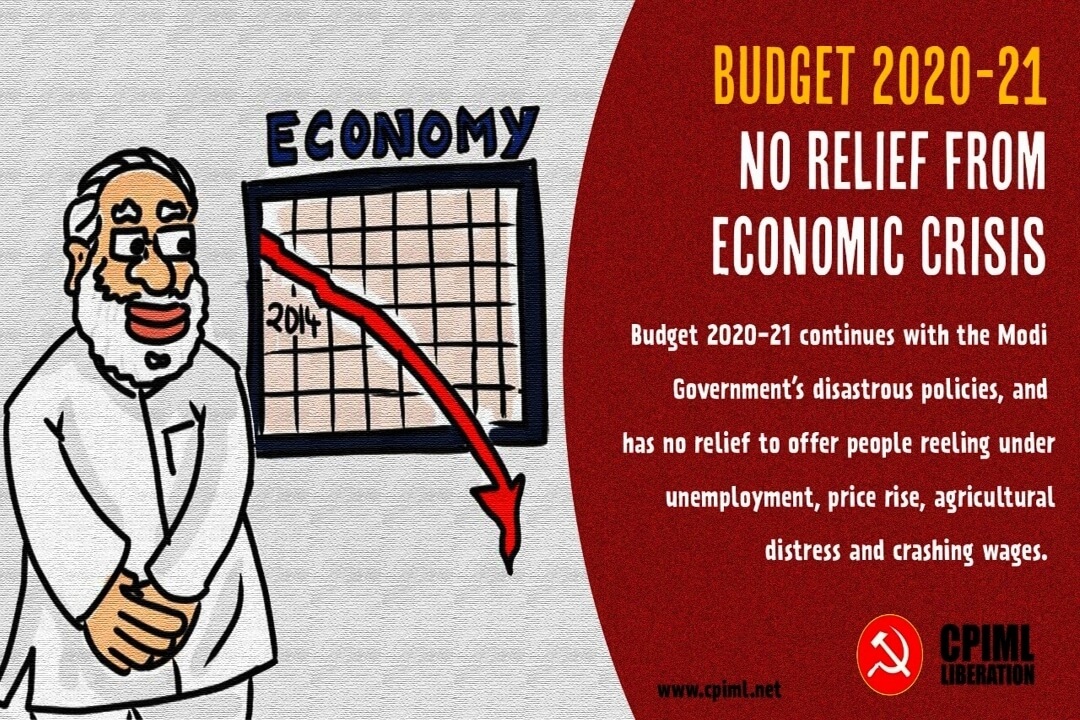Budget 2020-21: No Relief from Economic Crisis

BUDGET 2020-21 continues with the Modi Government’s disastrous policies, and has no relief to offer people reeling under unemployment, price rise, agricultural distress and crashing wages.
By the Budget documents' own admission, the percentage of casual labour in total employment has decreased. This at a time when BJP government was trying to casualise the workforce! This is an indication of dire employment scenario. 'Self employed' labour remains 50% as was in 2011, eight years back - also indicating rising unemployment.
The sell out of LIC is a step that will endanger the life and security of crores of policy holders of LIC on the one hand and make their social security more vulnerable. It also shows the government’s inability to raise revenue – it is thus snatching the people’s own money to subsidise its corporate cronies. The ‘strategic’ disinvestment of CPSUs continues despite popular demands for not doing so.
The Budget could have increased MNREGA coverage and funding to address the rural unemployment and wage crisis, and allocated funds in accordance with the demands of farmers’ organisations to accept the recommendations of the Swaminathan Commission. Instead it has come up with a 16 point programme which is nothing but a continuation of liberalisation measures in the agriculture sector paving the way further for the big corporates to take over the farming and agricultural lands. MNREGA allocation has actually been reduced from revised estimate of Rs. 71002 crores in 2019-20 to 61500 crores in 2020-21 while there are reports of unpaid wages, pending payments and no new works being assigned.
The disastrous policy of giving doles to the corporate sector at the cost of public sector companies continues. The budget gives some concrete tax benefits to the corporate sector in many forms, but at the same time has talked about decreasing the income tax limits which are optional. To opt for new Income Tax rates and to not avail the deductions will actually amount to the farewell to the long term practice of encouraging investments in public welfare, charity and donations which were covered under IT deductions. So this is regressive measure to discourage the expenditure by income tax payers into schemes/projects/institutions of public welfare.
The bank depositors’ insurance limit is increased from 1 lakh to Rs 5 lakhs. This is also an acknowledgement by the gov. that public money in banks is still not safe. People’s savings are being held captive so that corporates can continue plundering the banks. This is not acceptable. Every penny of common depositors be ensured to be safe and secure. The same government had forced people to deposit their hard earned money into banks through demonetisation. Moreover, people were not allowed to withdraw even the insured amount when they need it, this was seen in the PMC bank scam and other cases of similar scams.
The Budget’s talk of a new national policy for official statistics make us wary in the light of the fact that this government has manipulated the official statistical data to an unprecedented extent. The proposal to build data centre parks will enhance data imperialism, while data localisation has already been diluted by the Data Privacy Bill under US pressure. So far, the so-called Digital Governance has proved to be a digital disaster for citizens, now the proposal of more integration of data and establishment of data centers will also further the agenda of multinational behemoths in the digital monopoly world. It also raises the apprehension that the government plans to continue its policy of curtailing individual freedoms by surveiling people.

The revised budget estimate for the much publicised Aayushman Bharat was almost half of the estimated 6556 crores to only 3314 crores last year. This year again we have to see how much was actually spent on this scheme and how many benefitted. Similarly one third of the budget of PM-KISAN remained unspent last year.
The government is reducing its share capital in NABARD year by year, which is now only 1000 crores, just half of what it was two years ago gives an indication of the continuity of the policy shift in favour of private sector in the agriculture.
The Budget does nothing to promote railway safety and halt privatisation of the railways.
The Education sector privatisation measures are being strengthened which will be a disaster for the country when the government continues to attack educational environment and democracy inside the institutions of higher education of repute. The Budget also gives a lip service to the cause of women, scheduled castes and other vulnerable sections but without any substantial increase in budgetary allocations. The Swachh Bharat mission has already been a monumental failure, now without any substantial increase in its budget there actually remains no hope that manual scavengers will get justice in this country in near future!
From 2015-16 onwards the GDP continues to follow a downward trail, this year being the lowest. The budget does not give any course correction measure in this regard, while it is now clear that the continuing recession is Made in India and not a result of any global crisis.
The government has not paid heed to popular demands like 3K pension for all, regularisation of scheme workers and implementation of equal pay for equal work, all of which could have helped counter the recessionary trend. In sum, the Budget reads like a government propaganda pamphlet promising nothing in concrete that can save the falling economy and does nothing to increase employment, curb recession, increase demand – particularly in the rural sector, and goes on to maintain a status quo.
Charu Bhawan, U-90, Shakarpur, Delhi 110092
Phone: +91-11-42785864 | +91 9717274961 E-mail: info@cpiml.org

